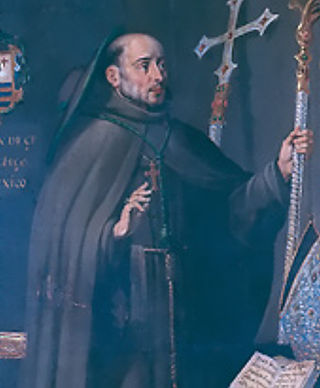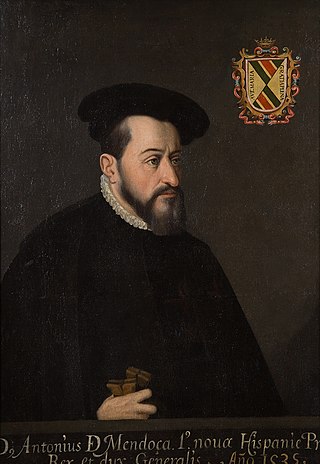Notes
This article needs additional citations for verification .(October 2019) |
Diego Delgadillo | |
|---|---|
| Member of the Real Audiencia of Mexico | |
| In office 9 December 1528 –9 January 1531 Servingwith Nuño de Guzmán and Juan Ortiz de Matienzo | |
| Preceded by | Alonso de Estrada &Luis de la Torre as Governor of New Spain |
| Succeeded by | Sebastián Ramírez de Fuenleal of the second Audiencia |
| Personal details | |
| Born | Granada,Castile |
| Died | 1533 Granada,Castile |
| Alma mater | University of Alcalá |
| Occupation | Judge,bureaucrat |
Diego Delgadillo (b. Granada,Spain,d. 1533,Granada) was a judge of the first Real Audiencia of Mexico,which took control of the governance of New Spain from the conquistadors from December 9,1528 to January 9,1531.
Delgadillo was a native of Granada. He graduated as a lawyer from the University of Alcalá.
Ever since the conquest by Hernán Cortés,New Spain had been governed by a military government,generally violent,arbitrary and exploitative of the Indigenous. Hoping to establish a more orderly and just government (and perhaps also to reduce the authority of Cortés),on December 13,1527 the metropolitan government of Charles V in Burgos named a Real (royal) Audiencia to take over the government of the colony. This consisted of a president and four oidores (judges). The president was Nuño Beltrán de Guzmán and the oidores were Juan Ortiz de Matienzo,Delgadillo,Diego Maldonado and Alonso de Parada. They left Spain for the Indies in August 1528. Maldonado and Parada became ill from the voyage and died soon after.
At the time Beltrán de Guzmán was already in New Spain,at Pánuco,so Charles ordered the judges to assemble in Veracruz and from there make a joint entrance into the capital. However,Beltrán de Guzmán was delayed. The oidores from Spain did not wait for his arrival,but proceeded directly to the capital. They arrived there on December 8,1528,taking over the government on the following day. They were given a splendid reception by the city government. Beltrán arrived a little after the others. Two of them (Maldonado and Parada) were sick on their arrival and soon died. They did not take part in the government.
The Audiencia was instructed to improve the treatment of the Indigenous and to conclude the juicios de residencia into the conduct of Cortés and his associates Pedro de Alvarado,Alonso de Estrada,Rodrigo de Albornoz,Gonzalo de Salazar and Pedro Almíndez Chirino within 90 days. Most of these associates had participated in the government in the proceeding few years while Cortés was in Honduras or Spain,with a lot of in-fighting among themselves and injustices to the population,both Indigenous and Spanish.
Cortés himself was still in Spain,where he was defending his conduct and appealing to Charles concerning his loss of authority. Cortés had some success with his appeal,being named Marqués del Valle de Oaxaca and receiving some other honors.
This Audiencia was very corrupt,and Delgadillo participated in the corruption,accumulating a large sum of money. He received a grant of land from the municipal council,which was illegal for the judges,and he had his brother appointed governor of the Zapoteca province. He soon entered into open opposition to Cortés,the bishops and the missionaries.
The Audiencia banned direct communication with the Court in Spain. This was so effective that Bishop Juan de Zumárraga felt the necessity of hiding a letter sealed in wax in a cask,to be smuggled to the Spanish authorities by a confederate sailor.
Delgadillo founded the Spanish settlement of Antequera (now Oaxaca) and suppressed a revolt of the Indigenous nearby. He imported the mulberry tree and the silkworm into the colony in 1530,becoming the first to begin sericulture in the New World. He imported the olive tree the following year.
The maladministration of the first Audiencia continued until the return of Cortés in July 1530. The members of the Audiencia intended to depose Cortés,but were prevented by the actions of Bishop Zumárraga. Shortly thereafter,the members of the second Audiencia arrived,taking power in January 1531. The second Audiencia was much different from the first,honest,capable and dedicated to good government and fair treatment of the Indigenous.
The members of the first Audiencia were called to answer before other courts. One hundred twenty-five lawsuits were begun. In one of the suits,Cortés accused Beltrán de Guzmán,Ortiz de Matienzo and Delgadillo of attempting to usurp his property and powers in New Spain during his absence in Spain in 1528. Delgadillo,like the others,was sentenced to lose all his repartimientos and to pay a large fine.
Thereafter Delgadillo returned to Spain,retiring to his native City. There a severe illness brought about by his troubles caused his death.
This article needs additional citations for verification .(October 2019) |

Juan de Zumárraga, OFM was a Spanish Basque Franciscan prelate and the first Bishop of Mexico. He was also the region's first inquisitor. He wrote Doctrina breve, the first book published in the Western Hemisphere by a European, printed in Mexico City in 1539.

Antonio de Mendoza was a Spanish colonial administrator who was the first viceroy of New Spain, serving from 14 November 1535 to 25 November 1550, and the third viceroy of Peru, from 23 September 1551, until his death on 21 July 1552.

Nuño Beltrán de Guzmán was a Spanish conquistador and colonial administrator in New Spain. He was the governor of the province of Pánuco from 1525 to 1533 and of Nueva Galicia from 1529 to 1534, and president of the first Royal Audiencia of Mexico – the high court that governed New Spain – from 1528 to 1530. He founded several cities in Northwestern Mexico, including Guadalajara.
Tactic is a town, with a population of 15,213, and a municipality in the Guatemalan department of Alta Verapaz. It is situated at 1,465 m above sea level. The municipality has a population of 38,052 and covers an area of 102 km². The languages spoken in Tactic are predominantly Spanish, Poqomchiʼ, and Q'eqchi'.

The Huexotzinco Codex or Huejotzingo Codex is a colonial-era Nahua pictorial manuscript, one of the group of manuscripts collectively known as Aztec codices. It is an eight-sheet document on amatl, a pre-European paper made in Mesoamerica,and consists of part of the testimony in a legal case against members of the First Audiencia in Mexico, particularly its president, Nuño de Guzmán, ten years after the Spanish conquest in 1521.

Vasco de Quiroga was the first bishop of Michoacán, Mexico, and one of the judges (oidores) in the second Real Audiencia of Mexico – the high court that governed New Spain – from January 10, 1531, to April 16, 1535.
Alonso de Estrada was a colonial official in New Spain during the period of Hernán Cortés' government, and before the appointment of the first viceroy. He was a member of the triumvirates that governed the colony for several short periods between 1524 and 1528, in the absence of Cortés.
Pedro Almíndez Chirino was a conquistador born in Úbeda and member of several councils that governed New Spain while Hernán Cortés was traveling to Honduras, in 1525-26. Almíndez was an ally of Gonzalo de Salazar; the events of this period are recounted in that article.
Sebastián Ramírez de Fuenleal was bishop of Santo Domingo and president of the Real Audiencia of Santo Domingo from 1528 to 1531. He was also president of the second Real Audiencia of Mexico from January 10, 1531 to April 16, 1535. Later he was a member of the Council of the Indies.
Francisco Ceinos was one of five oidores (judges) of the second Real Audiencia of Mexico. This group governed the colonies of New Spain from January 10, 1515 to April 16, 1535. Ceinos was also president of the audiencias that served as interim governments of New Spain from 1564 to 1566 and from approximately July 1568 to November of that year.
Juan Ortiz de Matienzo was a Spanish colonial judge and an original member of the first Real Audiencia of Santo Domingo, in 1512. From December 9, 1528 until January 9, 1531, he was a member of the first Real Audiencia of Mexico, which took over the governance of New Spain from the conquistadors.
Juan de Salmerón was a Spanish colonial official New Spain, and an oidor (judge) of the second Real Audiencia of Mexico, which governed the colony from January 10, 1531 until April 16, 1534. On the latter date, the government was turned over to Antonio de Mendoza, the first Viceroy of New Spain. Along with Fray Toribio de Benavente Motolinia he built the first European settlement at Puebla, Puebla.
Alonso de Maldonado Diez de Ledesma, was a Spanish lawyer and a member of the second Real Audiencia of Mexico, which governed New Spain from January 10, 1531 to April 16, 1535. He was also president of the first Real Audiencia of Guatemala, and in that capacity interim governor of Guatemala from 1536 to September 15, 1539. He was governor of Guatemala a second time, from 1542 to 1548.
The Real Audiencia of Mexico or Royal Audiencia of Mexico was the highest tribunal of the Spanish crown in the Kingdom of New Spain. The Audiencia was created by royal decree on December 13, 1527, and was seated in the viceregal capital of Mexico City. The First Audiencia was dissolved by the crown for its bungling and corruption and the crown established the Second Audiencia in 1530. This was supplanted by the Viceroyalty of New Spain in 1535. A new Audiencia was created in Guadalajara in western Mexico in 1548.
The Real Audiencia of Guadalajara, was the highest tribunal of the Spanish crown in what is today northern Mexico and the southwestern United States in the Viceroyalty of New Spain. It was created by royal decree on February 13, 1548, and was originally located in Compostela and permanently seated in Guadalajara in 1560. Its president was the chief political and executive officer of the district, subordinated only to the Viceroy.
The Real Audiencia of Manila was the Real Audiencia of the Spanish East Indies, which included modern-day Guam, the Northern Mariana Islands, Palau, Micronesia and the Philippines. Similar to Real Audiencias throughout the Spanish Empire, it was the highest tribunal within the territories of the Captaincy General of the Philippines, a dependency of the Viceroyalty of New Spain.

An oidor was a judge of the Royal Audiencias and Chancillerías, originally courts of Kingdom of Castile, which became the highest organs of justice within the Spanish Empire. The term comes from the verb oír, "to hear," referring to the judge's obligation to listen to the parts of a judicial process, particularly during the phase of pleas.
The Royal Audience and Chancery of Panama in Tierra Firme was a governing body and superior court in the New World empire of Spain. The Audiencia of Panama was the third American audiencia after the ones of Santo Domingo and Mexico. It existed three times under various guises since it first creation in 1538 until its ultimate abolition in 1751.
![]() This article incorporates text from a publication now in the public domain : Wilson, J. G.; Fiske, J., eds. (1891). Appletons' Cyclopædia of American Biography . New York: D. Appleton.
This article incorporates text from a publication now in the public domain : Wilson, J. G.; Fiske, J., eds. (1891). Appletons' Cyclopædia of American Biography . New York: D. Appleton.{{cite encyclopedia}}: Missing or empty |title= (help)